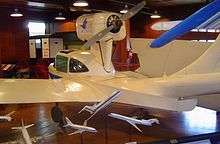Taylor Coot
| Coot | |
|---|---|
| Role | Civil utility amphibian |
| Manufacturer | Richard Steeves |
| Designer | Moulton Taylor |
| First flight | 1969 |
| Status | Plans available (2015) |
| Number built | 70 |
| Unit cost |
$3500 in 1970[1] |
The Taylor Coot is a two-seat homebuilt amphibious aircraft designed by Moulton Taylor, famous for his flying car designs. When a market for the Aerocar did not emerge, Taylor turned to more conventional designs. The Coot was nonetheless somewhat unusual for its low wing, a feature uncommon on most seaplanes and flying boats, which conventionally strive to keep their wings as far away from the water as possible. Instead, Taylor designed the Coot's wing roots to act as sponsons to stabilise the craft in the water. The arrangement allowed him to do away with the weight and drag penalties imposed by wingtip floats, and additionally gain ground effect benefits during takeoff. First flown in 1969, the Coot proved very popular with homebuilders, with an estimated 70 aircraft completed by 2007.
The wings and elevator surfaces of the Taylor Coot can be folded for transport and storage. With wings folded the aircraft is 8 feet (2.4 m) wide. Some builders have equipped their aircraft with auxiliary sponsons. It is equipped with tricycle landing gear: The nosewheel casters freely and steering on the ground is accomplished with differential braking of the main gear.
The plans and three books about the Coot are available through Richard Steeves of Madison, Wisconsin.[2]
Variants
- Coot model A
- Single-tailed version.
- Coot model B
- Two-tailed model

Specifications (Super Coot Model A, 180 hp Franklin engine)
Data from Jane's All The World's Aircraft 1982–83[3]
General characteristics
- Crew: one pilot
- Capacity: one passenger
- Length: 22 ft 0 in (6.71 m)
- Wingspan: 36 ft 0 in (10.97 m)
- Height: 8 ft 0 in (2.44 m)
- Wing area: 180 ft² (16.7 m²)
- Empty weight: 1,100 lb (499 kg)
- Max. takeoff weight: 1,950 lb (884 kg)
- Powerplant: 1 × Franklin air-cooled flat-six, 180 hp (134 kW)
Performance
- Never exceed speed: 139 mph (120 knots, 223 km/h)
- Maximum speed: 130 mph (113 knots, 209 km/h)
- Cruise speed: 110 mph (95.5 knots, 177 km/h)
- Rate of climb: 1,250 ft/min (6.4 m/s)
See also
Aircraft of comparable role, configuration and era
References
- John W. R. Taylor. Jane's All The World's Aircraft 1982–83. London:Jane's Yearbooks, 1982. ISBN 0-7106-0748-2.
External links
| Wikimedia Commons has media related to Taylor Coot. |